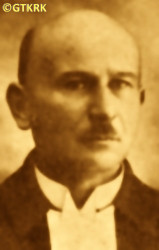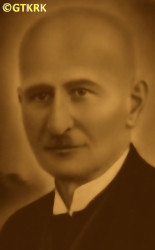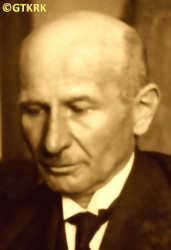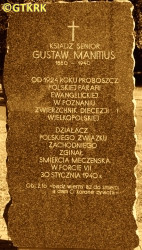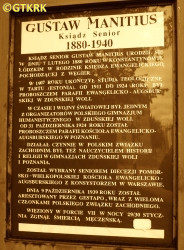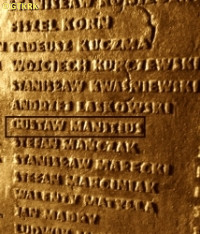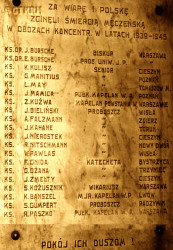Roman Catholic
St Sigismund parish
05-507 Słomczyn
85 Wiślana Str.
Konstancin deanery
Warsaw archdiocese, Poland
full list:
displayClick to display full list

searchClick to search full list by categories
wyświetlKliknij by wyświetlić pełną listę po polsku

szukajKliknij by przeszukać listę wg kategorii po polsku

Martyrology of the clergy — Poland
XX century (1914 – 1989)
personal data
surname
MANITIUS
forename(s)
Gustav (pl. Gustaw)
function
superintendent
creed
Evangelical Church of the Augsburg Confession in Poland EA
diocese / province
Pomeranian‐Poznań seniority (commissariat)more on
pl.wikipedia.org
[access: 2014.08.18]
Greeter Poland seniority (commissariat)more on
pl.wikipedia.org
[access: 2019.04.16]
date and place
of death
30.01.1940

KL Posenconcentration camp
today: Poznań, Poznań city pov., Greater Poland voiv., Poland
more on
en.wikipedia.org
[access: 2022.01.09]
alt. dates and places
of death
28‑29.01.1940
details of death
During World War I organiser of suport and help to Polish inhabitants and of process of polonisation of system of schooling in Zduńska Wola.
Just before the outbreak of World War II, his name, as an activist of Polish patriotic organizations, was placed on German proscription lists, prepared mainly by the so‐called 5th column — Polish citizens, usually of German descent (there are indications, though disputed, that in 08.1939 in Poznań, in the headquarters of the Evangelical Union House, secret weapons stashes were discovered, and in other buildings, radio transmitters prepared for German spies and saboteurs).
After German and Russian invasion of Poland in 09.1939 and start of the World War II, after start of German occupation, arrested by the Germans on 09.10.1939 Jailed in Młyńska Str. German political police Gestapo prison in Poznań and next from 12.1939 in KL Posen (Fort VII) concentration camp.
There, tortured and injured, was clubbed to death with sticks ‐ Germans ordered him and few other Polish (including Catholic priest, Fr Marian Poprawski) prisoners to run along a narrow side corridor and started to shoot at them.
According to the death certificate in the registers of the civil registry office in Poznań, No. 11/1272/1940, the „honest” otherwise German „medical doctors” and formalists — and at the same time, unrivaled fairy tale spinners — noted the cause of death was „decreased blood circulation”.
cause of death
murder
perpetrators
Germans
sites and events
KL PosenClick to display the description, UH PosenClick to display the description, «Intelligenzaktion»Click to display the description, Ribbentrop‐MolotovClick to display the description
date and place
of birth
07.02.1880

Konstantynów Łódzkitoday: Konstantynów Łódzki urban gm., Pabianice pov., Łódź voiv., Poland
more on
en.wikipedia.org
[access: 2021.12.19]
presbyter (holy orders)
ordination
10.02.1907

Warsawtoday: Warsaw city pov., Masovia voiv., Poland
more on
en.wikipedia.org
[access: 2021.10.09]
positions held
1937 – 1939
superintendent–senior — Poznańtoday: Poznań city pov., Greater Poland voiv., Poland
more on
en.wikipedia.org
[access: 2021.07.18] ⋄ Greater Poland EA seniority (commissariat) — also: member of the Synod of the Evangelical–Augsburg Church; acting („ad interim”) administrator of Ostrzeszów/Pawłów German churches (1939)
1924 – 1939
parish priest — Poznańtoday: Poznań city pov., Greater Poland voiv., Poland
more on
en.wikipedia.org
[access: 2021.07.18] ⋄ EA parish — till 1937 pastor of the „Poznań church”; also: co‐organizer of the filial church in Leszno (1925); member of the editorial committee of the „Evangelical Voice” weekly (1924‐1929), published in Warsaw; member of Polish patriotic organizations, the Union for the Defense of the Western Borderlands and the Polish Western Union
superintendent–senior — Poznańtoday: Poznań city pov., Greater Poland voiv., Poland
more on
en.wikipedia.org
[access: 2021.07.18] ⋄ Pomeranian‐Poznań EA seniority (commissariat) — co‐founder of Gdynia church (1931); also: acting („ad interim”) administrator of German churches in Bydgoszcz and Toruń
1911 – 1924
parish priest — Zduńska Wolatoday: Zduńska Wola urban gm., Zduńska Wola pov., Łódź voiv., Poland
more on
en.wikipedia.org
[access: 2021.12.18] ⋄ EA parish — also: pastor of the filial church in Łask; acting („ad interim”) administrator of Wieluń parish (1920‐1922); chairman of the Town Council in Zduńska Wola (1917‐1919); one of the founding fathers of the Henry Sienkiewicz's Society (secretary of the first board of the Society), which in c. 1916 led to the transformation of the four–grade RealSchule, established in c. 1915, into the eight–grade Henry Sienkiewicz's Coeducational Philological Gymnasium, and then in 1921 to its transformation into the Casimir the Great's State Co–educational Gymnasium; prob. school prefect and history teacher
1910 – 1911
administrator — Zduńska Wolatoday: Zduńska Wola urban gm., Zduńska Wola pov., Łódź voiv., Poland
more on
en.wikipedia.org
[access: 2021.12.18] ⋄ EA parish
1909 – 1910
vicar — Zduńska Wolatoday: Zduńska Wola urban gm., Zduńska Wola pov., Łódź voiv., Poland
more on
en.wikipedia.org
[access: 2021.12.18] ⋄ EA parish
1909
vicar — Osówkatoday: Sierpc gm., Sierpc pov., Masovia voiv., Poland
more on
en.wikipedia.org
[access: 2023.03.24] ⋄ EA parish
vicar — Lipnotoday: Lipno gm., Lipno pov., Kuyavia‐Pomerania voiv., Poland
more on
en.wikipedia.org
[access: 2020.11.01] ⋄ EA parish
1907 – 1909
vicar — Łódźtoday: Łódź city pov., Łódź voiv., Poland
more on
en.wikipedia.org
[access: 2021.07.18] ⋄ Holy Trinity EA parish
1901 – 1906
student — Dorpattoday: Tartu, Tartu city mun., Tartu cou., Estonia
more on
en.wikipedia.org
[access: 2023.03.24] ⋄ Evangelical Theology Department, University of Dorpat — also: co‐founder of the Polish Theologians Group
married — two sons
others related
in death
BANSZELClick to display biography Charles, BIELIŃSKIClick to display biography Joseph, BURSCHEClick to display biography Edmund, BURSCHEClick to display biography Julius, FALZMANNClick to display biography Alexander Charles, FREYDEClick to display biography Alfred, GNIDAClick to display biography Francis, GUMPERTClick to display biography Steven Edward, GUTKNECHTClick to display biography Bruno, GUTSCHClick to display biography Sigismund, HAUSEClick to display biography Paul Henry, KAHANEClick to display biography George, KOŻUSZNIKClick to display biography Stanislav, KULISZClick to display biography Charles, KUŹWAClick to display biography Sigismund, LEHMANNClick to display biography George, MAYClick to display biography Leo Witold, MAMICAClick to display biography Joseph, NIEROSTEKClick to display biography Joseph, NITSCHMANNClick to display biography Adam Robert, OŻANAClick to display biography Gustav, PASZKOClick to display biography Richard, PAWLASClick to display biography Vladislav, WAGNERClick to display biography Richard Ernest, ZMEŁTYClick to display biography Adolph
sites and events
descriptions
KL Posen: German Posen — Fort VII — camp founded in c. 10.10.1939 in Poznań till mid of 11.1939 operated formally as Germ. Konzentrationslager (Eng. concentration camp) KL Posen, and this term is used throughout the White Book, also later periods. It was first such a concentration camp set up by the Germans on Polish territory — in case of Greater Poland (Wielkopolska) directly incorporated into German Reich. In 10.1939 in KL Posen for the first time Germans used gas to murder civilian population, in particular patients of local psychiatric hospitals. From 11.1939 the camp operated as German political police Gestapo prison and transit camp (Germ. Übergangslager), prior to sending off to concentration camps, such as KL Dachau or KL Auschwitz. In 28.05.1941 the camp was rebranded as police jail and slave labour corrective camp (Germ. Arbeitserziehungslager). At its peak up to 7‐9 executions were carried in the camp per day, there were mass hangings of the prisoners and some of them were led out to be murdered elsewhere, outside of the camp. Altogether in KL Posen Germans exterminated approx. 20,000 inhabitants of Greater Poland (Wielkopolska) region, including many representatives of Polish intelligentsia, patients and staff of psychiatric hospitals and dozen or so Polish priests. Hundreds of priests were held there temporarily prior to transport to other concentration camps, mainly KL Dachau. From 03.1943 the camp had been transformed into an industrial complex (from 25.04.1944 — Telefunken factory manufacturing radios for submarines and aircrafts). (more on: www.wmn.poznan.plClick to attempt to display webpage
[access: 2019.02.02], en.wikipedia.orgClick to attempt to display webpage
[access: 2013.12.27])
UH Posen: Germ. Untersuchungshaftanstalt Posen (Eng. Poznań Detention Centre), run by the Germ. Geheime Staatspolizei (Eng. Secret State Police), i.e. Gestapo, at 1 Młyńska Str. in Poznań. Death sentences by guillotine and hanging were also carried out there — in total, during World War II, the Germans are said to have murdered at least 1,639 people there (1,532 men, 93 women and 14 children — people under the age of 18), including c. 1,400 people who were probably killed by guillotine. Convicts in custody were greeted: Germ. „Wir werden auch mit dir fertig sein — Kopf herunter” (Eng. „We will finish you too — keep your head down”). Sentences were usually carried out on Tuesdays and Fridays, around on 06:00. According to the testimony of one of the German executioners: „Two assistants took the condemned by the arms and led him to a bench, where they laid him face down. The head stuck out above the bathtub. A special board pressed the condemned man's neck. At the prosecutor's call, the executioner dropped a knife weighing 2–3 hundredweight. The severed head fell into the bathtub”. (more on: pl.wikipedia.orgClick to attempt to display webpage
[access: 2013.10.05])
«Intelligenzaktion»: German: «Intelligenzaktion» (English: „Intelligence Action”) — a German program of extermination of the Polish elite, mainly the intelligentsia and leadership layers, carried out from the beginning of the occupation in w 09.1939 to 04.1940, mainly in territories directly annexed to Germany, but also in the so‐called Germ. Generalgouvernement (Eng. General Governorate), where it was called «AB‐aktion». In the first phase, immediately after the beginning of the German occupation, during military operations carried out by the Germ. Wehrmacht (Eng. Armed Forces) and the genocidal units of the Germ. Einsatzgruppen (Eng. Operational Groups) of the Germ. Sicherheitspolizei (Eng. Security Police), i.e. SiPo, and Germ. Sicherheitsdienst des Reichsführers SS (Eng. Security Service of the Reichsführer SS), i.e. SD, organized by the Germ. Reichssicherheitshauptamt (Eng. Reich Main Security Office), i.e. RSHA, which followed the troops, carried out under the Germ. Unternehmen „Tannenberg” (Eng. Operation „Tannenberg”) — based on the so‐called Germ. Sonderfahndungsliste (Eng. Special Wanted Lists), i.e. proscription lists of Poles considered particularly dangerous to the Third Reich, prepared by the Zentralstelle II/P (Polen) unit of the German RSHA. Later, implemented by the German civilian occupation authorities and the genocidal unit of the Germ. Volksdeutscher Selbstschutz (Eng. Ethnic Germans Self‐Defense), whose members were Germ. Volksdeutsche (Eng. Ethnic Germans), i.e. representatives of the German minority in Poland. According to various sources, these lists, at the beginning of 09.1939, could have contained the details of 61,000—88,000 „dangerous” Poles — although these figures cannot be confirmed. In total, during this genocide, c. 50,000 teachers, Catholic priests, representatives of the landed gentry, freelancers, social and political activists, and retired military personnel were systematically and methodically murdered. Another 50,000 were sent to concentration camps, where only a negligible percentage survived. (more on: en.wikipedia.orgClick to attempt to display webpage
[access: 2014.10.04])
Ribbentrop‐Molotov: Genocidal Russian‐German alliance pact between Russian leader Joseph Stalin and German leader Adolf Hitler signed on 23.08.1939 in Moscow by respective foreign ministers, Mr. Vyacheslav Molotov for Russia and Joachim von Ribbentrop for Germany. The pact sanctioned and was the direct cause of joint Russian and German invasion of Poland and the outbreak of the World War II in 09.1939. In a political sense, the pact was an attempt to restore the status quo ante before 1914, with one exception, namely the „commercial” exchange of the so‐called „Kingdom of Poland”, which in 1914 was part of the Russian Empire, fore Eastern Galicia (today's western Ukraine), in 1914 belonging to the Austro‐Hungarian Empire. Galicia, including Lviv, was to be taken over by the Russians, the „Kingdom of Poland” — under the name of the General Governorate — Germany. The resultant „war was one of the greatest calamities and dramas of humanity in history, for two atheistic and anti‐Christian ideologies — national and international socialism — rejected God and His fifth Decalogue commandment: Thou shall not kill!” (Abp Stanislav Gądecki, 01.09.2019). The decisions taken — backed up by the betrayal of the formal allies of Poland, France and Germany, which on 12.09.1939, at a joint conference in Abbeville, decided not to provide aid to attacked Poland and not to take military action against Germany (a clear breach of treaty obligations with Poland) — were on 28.09.1939 slightly altered and made more precise when a treaty on „German‐Russian boundaries and friendship” was agreed by the same murderous signatories. One of its findings was establishment of spheres of influence in Central and Eastern Europe and in consequence IV partition of Poland. In one of its secret annexes agreed, that: „the Signatories will not tolerate on its respective territories any Polish propaganda that affects the territory of the other Side. On their respective territories they will suppress all such propaganda and inform each other of the measures taken to accomplish it”. The agreements resulted in a series of meeting between two genocidal organization representing both sides — German Gestapo and Russian NKVD when coordination of efforts to exterminate Polish intelligentsia and Polish leading classes (in Germany called «Intelligenzaktion», in Russia took the form of Katyń massacres) where discussed. Resulted in deaths of hundreds of thousands of Polish intelligentsia, including thousands of priests presented here, and tens of millions of ordinary people,. The results of this Russian‐German pact lasted till 1989 and are still in evidence even today. (more on: en.wikipedia.orgClick to attempt to display webpage
[access: 2015.09.30])
sources
personal:
old.luteranie.plClick to attempt to display webpage
[access: 2012.11.23], pl.wikipedia.orgClick to attempt to display webpage
[access: 2013.10.05], opus4.kobv.deClick to attempt to display webpage
[access: 2023.03.24], www.miejscapamiecinarodowej.plClick to attempt to display webpage
[access: 2013.12.04], www.przybylscy.plClick to attempt to display webpage
[access: 2013.08.10]
original images:
poznan.ap.gov.plClick to attempt to display webpage
[access: 2019.04.16], commons.wikimedia.orgClick to attempt to display webpage
[access: 2019.04.16], dzieje.plClick to attempt to display webpage
[access: 2019.04.16], hiveminer.comClick to attempt to display webpage
[access: 2019.04.16], lepczynski.euClick to attempt to display webpage
[access: 2019.04.16], gloria.skoczow.plClick to attempt to display webpage
[access: 2019.04.16], www.miejscapamiecinarodowej.plClick to attempt to display webpage
[access: 2013.12.04]
LETTER to CUSTODIAN/ADMINISTRATOR
If you have an Email client on your communicator/computer — such as Mozilla Thunderbird, Windows Mail or Microsoft Outlook, described at WikipediaPatrz:
en.wikipedia.org, among others — try the link below, please:
LETTER to CUSTODIAN/ADMINISTRATORClick and try to call your own Email client
If however you do not run such a client or the above link is not active please send an email to the Custodian/Administrator using your account — in your customary email/correspondence engine — at the following address:

giving the following as the subject:
MARTYROLOGY: MANITIUS Gustav
To return to the biography press below:
 Click to return to biography
Click to return to biography








